I've been working on a pair of legs that self-balance. If his 'waist' goes below a certain y-position value (falling over/tripping), the area is supposed to reset and also deduct points from his reward-score. I'm awfully new to machine learning, so go easy on me! Why is the agent not resetting when he falls over?
Code to Agent (Updated):
using MLAgents;
using System;
using System.Collections;
using System.Collections.Generic;
using UnityEngine;
using MLAgents;
using System;
using System.Collections;
using System.Collections.Generic;
using UnityEngine;
public class BalanceAgent : Agent
{
private BalancingArea area;
public GameObject waist;
public GameObject buttR;
public GameObject buttL;
public GameObject thighR;
public GameObject thighL;
public GameObject legR;
public GameObject legL;
public GameObject footR;
public GameObject footL;
//public GameObject goal;
// private float buttR = 0f;
public GameObject[] bodyParts = new GameObject[9];
public Vector3[] posStart = new Vector3[9];
public Vector3[] eulerStart = new Vector3[9];
public override void InitializeAgent() {
base.InitializeAgent();
area = GetComponentInParent<BalancingArea>();
bodyParts = new GameObject[]{waist, buttR, buttL, thighR, thighL, legR, legL, footR, footL};
for(int i = 0; i < bodyParts.Length; i++) {
posStart[i] = bodyParts[i].transform.position;
eulerStart[i] = bodyParts[i].transform.eulerAngles;
}
}
public override void AgentReset() {
for (int i = 0; i < bodyParts.Length; i++) {
bodyParts[i].transform.position = posStart[i];
bodyParts[i].transform.eulerAngles = eulerStart[i];
bodyParts[i].GetComponent<Rigidbody>().velocity = Vector3.zero;
bodyParts[i].GetComponent<Rigidbody>().angularVelocity = Vector3.zero;
}
}
public override void AgentAction(float[] vectorAction) {
int buttRDir = 0;
int buttRVec = (int)vectorAction[0];
switch (buttRVec) {
case 3:
buttRDir = 0;
break;
case 1:
buttRDir = -1;
break;
case 2:
buttRDir = 1;
break;
}
buttR.transform.Rotate(0, buttRDir, 0);
int buttLDir = 0;
int buttLVec = (int)vectorAction[1];
switch (buttLVec) {
case 3:
buttLDir = 0;
break;
case 1:
buttLDir = -1;
break;
case 2:
buttLDir = 1;
break;
}
buttL.transform.Rotate(0, buttLDir, 0);
int thighRDir = 0;
int thighRVec = (int)vectorAction[2];
switch (thighRVec) {
case 3:
thighRDir = 0;
break;
case 1:
thighRDir = -1;
break;
case 2:
thighRDir = 1;
break;
}
thighR.transform.Rotate(0, thighRDir, 0);
int thighLDir = 0;
int thighLVec = (int)vectorAction[3];
switch (thighLVec) {
case 3:
thighLDir = 0;
break;
case 1:
thighLDir = -1;
break;
case 2:
thighLDir = 1;
break;
}
thighL.transform.Rotate(0, thighLDir, 0);
int legRDir = 0;
int legRVec = (int)vectorAction[4];
switch (legRVec) {
case 3:
legRDir = 0;
break;
case 1:
legRDir = -1;
break;
case 2:
legRDir = 1;
break;
}
legR.transform.Rotate(0, legRDir, 0);
int legLDir = 0;
int legLVec = (int)vectorAction[5];
switch (legLVec) {
case 3:
legLDir = 0;
break;
case 1:
legLDir = -1;
break;
case 2:
legLDir = 1;
break;
}
legL.transform.Rotate(0, legLDir, 0);
int footRDir = 0;
int footRVec = (int)vectorAction[6];
switch (footRVec) {
case 3:
footRDir = 0;
break;
case 1:
footRDir = -1;
break;
case 2:
footRDir = 1;
break;
}
footR.transform.Rotate(0, footRDir, 0);
int footLDir = 0;
int footLVec = (int)vectorAction[7];
switch (footLVec) {
case 3:
footLDir = 0;
break;
case 1:
footLDir = -1;
break;
case 2:
footLDir = 1;
break;
}
footL.transform.Rotate(0, footLDir, 0);
//buttR = vectorAction[0]; //Right or none
//if (buttR == 2) buttR = -1f; //Left
if (waist.transform.position.y > -1) {
AddReward(.1f);
}
else {
AddReward(-.02f);
}
if (waist.transform.position.y <= -3) {
print("reset!");
AddReward(-.1f);
Done();
}
public override void CollectObservations() {
AddVectorObs(waist.transform.localEulerAngles.y);
AddVectorObs(buttR.transform.localEulerAngles.x);
AddVectorObs(buttL.transform.localEulerAngles.x);
AddVectorObs(thighR.transform.localEulerAngles.y);
AddVectorObs(thighL.transform.localEulerAngles.y);
AddVectorObs(legR.transform.localEulerAngles.y);
AddVectorObs(legL.transform.localEulerAngles.y);
AddVectorObs(footR.transform.localEulerAngles.y);
AddVectorObs(footL.transform.localEulerAngles.y);
AddVectorObs(waist.transform.position);
}
}
Code to Area:
using MLAgents;
using System.Collections;
using System.Collections.Generic;
using System.Linq;
using UnityEngine;
public class BalancingArea : Area
{
public List<BalanceAgent> BalanceAgent { get; private set; }
public BalanceAcademy BalanceAcademy { get; private set; }
public GameObject area;
private void Awake() {
BalanceAgent = transform.GetComponentsInChildren<BalanceAgent>().ToList(); //Grabs all agents in area
BalanceAcademy = FindObjectOfType<BalanceAcademy>(); //Grabs balance acedem
}
private void Start() {
}
public void ResetAgentPosition(BalanceAgent agent) {
agent.transform.position = new Vector3(area.transform.position.x, 0, area.transform.position.z);
agent.transform.eulerAngles = new Vector3(0,0,0);
}
// Update is called once per frame
void Update()
{
}
}
Code to BalanceAcademy:
using MLAgents;
using System.Collections;
using System.Collections.Generic;
using UnityEngine;
public class BalanceAcademy : Academy
{
}
Command used to run trainer:
mlagents-learn config/trainer_config.yaml --run-id=balancetest09 --train



